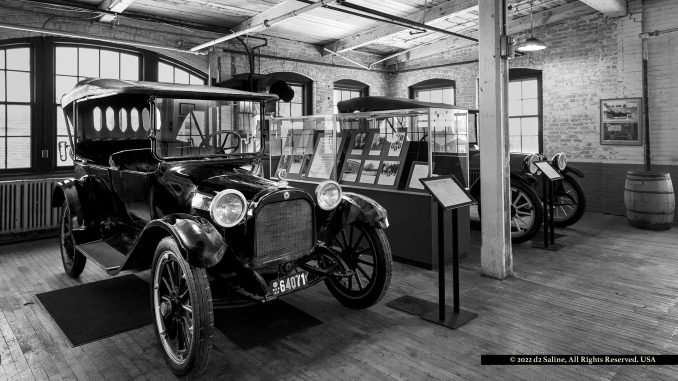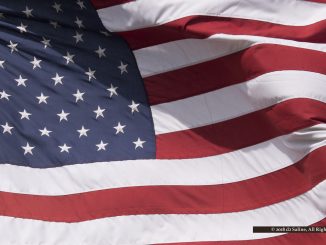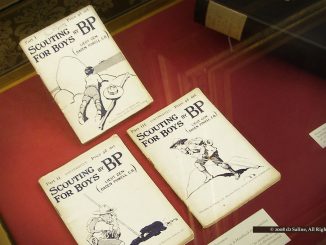
Brothers John and Horace Dodge were a formidable force as backbone to the nascent American automobile industry when they advertised the first car that was to carry their own name, in the August 29, 1914, edition of Saturday Evening Post. [1-5]
Part I of this two-part series provided an introduction to the history that substantiates the above summary. That reporting set out a sequence that necessarily passed through the Ford Motor Company Piquette Avenue plant — now museum — in Detroit. [6,7]
Biographer Charles K Hyde may be cited at this point. He has noted that, by late summer 1914, their brand was powerful enough that not one of their paid promotions “included illustrations or specifications for [their] new automobile.
The Dodges deliberately and effectively created enormous public anticipation by revealing nothing about the new car.
Company materials published in the mid-1930s authoritatively set 1914 through 1916 as production years for that very first generation car when it did appear, serially numbered 1 to 95489. These were not to be distinguished by model year, name, or number, as early Ford letter-cars had been. Neither, however, were they stayed technology, following any sort of Model T philosophy — which had, in fact, been a central point of contention in separating Henry Ford and the Dodge brothers. [8-11]
In fact, print materials that accompanied delivery of Dodge Brothers motor cars specifically stated that it was company “policy to adopt improvements just as soon as the advisability of making them has been thoroughly demonstrated.” [12,13]
Up to this point, Saline Journal has reported on this history in terms of pre-Dodge, then Dodge-brand, as ongoing refinement evolutions that brought this motor car vintage to the road. But it may be that key stories with which these 95,489 are associated after emerging from the Dodge Hamtramck production line are just as important to understanding their appeal now over a century later.
And maybe more so.
For example, “the first Dodge in Alaska” was equipped to emerge from the Fountainhead Antique Auto Museum under its own horsepower in 2013, thanks to the passion and investment of skilled chassis and powertrain mechanics. [14-16]
The history of that automobile centered on its having been “heavily” run on the 368-mile Gibson auto stage line between Fairfax and Valdez over the course of a decade of service that ended in 1926. Its uncommon all-steel construction was, as one museum staffer noted, “kind of important back then, because the wooden bodies had a tendency to kind of come apart when you really used them rough on the trail.” [17]
He went on to say that this 1916 Dodge was “a lot of fun to get out and drive around; and it runs pretty dang nice now.”
Most recently (and relatively closer to home), the $100-million National Museum of Military Vehicles in Wyoming held its grand opening on August 7, 2020. Its General George S Patton, Jr Gallery featured a Dodge Touring Car. [18,19]
Its context can be seen in a newspaper article dated August 15, 1916, which quoted an Army officer with regard to the performace of these vehicles during military deployments. “We had practically to make our own roads, and from what the Dodge Brothers Car showed on that trip, I believe it could climb a wall.” [20]
A 1915 Dodge Brothers touring car was one of the first “ever used in US combat operations,” and “first-generation Dodges stayed in military livery well into the 1930s.” [21,22]
“Gen John J ‘Blackjack’ Pershing rode in the 1915 Dodge Brothers touring car as he led 12,000 US troops into Mexico in 1916 in search of the revolutionary Pancho Villa; his drivers were Lt Eddie Rickenbacker who later made a name for himself as a World War I flying ace and Lt George Patton who went on to World War II fame.”
As reported by Josh Welton three summers ago for Dodge Garage, “This was in the spring of 1916, and Gen Pershing was on the cutting edge of Warcraft, which was becoming increasingly mechanized. Even at this point, most soldiers used horses, but that was rapidly changing …. [23]
The terrain in northeast Mexico tested the grit of man and machine alike. Pershing special ordered Dodge Brothers touring cars for the expedition ….
In the first motorized military attack in United States history, George Patton led a trio of Dodge touring cars — in Pershing’s personal car — to strike a farm where Cardenas, Poncho Villa’s right hand man, was hiding.
The performance stories of early American motor cars, à la Dodge Brothers, continue to show value in connecting people to history.
One such repository is that of retired United States Air Force Chief Master Sergeant Jeanne Reed, who in 2012 launched a popular website that was dedicated to recalling them — from the perspective of a Dodge Brothers dealership founded by her grandfather in October of 1915. [24]
Similarly, the Ford Piquette Avenue Plant serves as home to physical examples; in fact, it is a truly exceptional, must-visit museum. It is obviously important for the Ford-branded vehicles within, and, certainly, as itself a preserved environment of American innovation and manufacturing. [25]
But it must also be considered an indispensible stop for anyone interested in finding the earliest founders-produced Dodge brothers vehicles.
And, for those open to it, getting a feel for what drove John and Horace Dodge, and perhaps evening imagining what might have been, had either man lived to see the results fully play out through the end of their intended competition with the Model T and Ford Motor Company. [26]
References
- “Remembering the Famous Dodge Brothers, a Brief History” Robert Tate (March 13, 2019) Motor Cities.
- “Dodge History” logansportauto (March 14, 2011) YouTube (13:16 minutes).
- The Dodge Brothers: The Men, the Motor Cars, and the Legacy, Charles K Hyde (2005) Wayne State University Press.
- “Arsenal of Democracy: Dodge Brothers Build a Reputation” Josh Welton (May 21, 2019) Dodge Garage.
- “Dodge Brothers: From family ownership to corporate underling” (January 7, 2020) Deutsche Welle (DW).
- “Findings from Dodge Brothers Club trip to Detroit this week, connecting with earliest founders-produced car(s): Part I” Dell Deaton (June 24, 2022) Saline Journal.
- The Ford Piquette Avenue Plant (home page).
- Dodge Brothers Passenger Car Master Parts List: Final Edition for All Models Prior to 1934 (May 1, 1934) Chrysler Motors Parts Corporation.
- “Ford Piquette Avenue Plant: 1915 Dodge Brothers Touring” (2015) Ford Piquette Plant.
- “1915 Dodge Brothers Touring” (2015) Ford Piquette Plant.
- “Memorandum from Ernest Kanzler to Henry Ford regarding Replacing the Model T, 1926” Ernest Kanzler (January 26, 1926) The Henry Ford.
- Parts Price List (March 1, 1916) Dodge Brothers Motor Car: Detroit.
- Book of Information (April 1, 1916) Dodge Brothers Motor Car.
- “1916 Dodge Brothers Part 1 – Fountainhead Museum – Fairbanks Alaska” Fountainhead Antique Auto Museum (March 19, 2013) YouTube (5:00 minutes).
- “1916 Dodge Brothers Part 2 – Fountainhead Museum – Fairbanks Alaska” Fountainhead Antique Auto Museum (March 19, 2013) YouTube (4:26 minutes).
- Fountainhead Antique Auto Museum (home page).
- “The Richardson Highway and the Gibson stage line” Ray Bonnell (June 12, 2019) Fairbanks Daily News-Minor.
- National Museum of Military Vehicles (home page).
- “Dodge Touring cars also have a story about George Patton during the Mexican Border War” (March 4, 2021) National Museum of Military Vehicles (Facebook Page).
- “General Pershing in Dodge Brothers Car” (August 15, 1916) The Mildura Telegraph and Darling and Lower Murray Advocate.
- “1918 Dodge Staff Car: Still serving coast-to-coast” Jim Allen (August 31, 2010) Autoweek.
- “Dodge Brothers – 1915. 4-door touring” The Antique Automobile Club of America (AACA) Library.
- “Arsenal of Democracy: America’s First Motorized Attack” Josh Welton (July 22, 2019) Dodge Garage.
- Reed Brothers Dodge History 1915 – 2012 (home page). “Arsenal of Democracy: America’s First Motorized Attack” Josh Welton (July 22, 2019) Dodge Garage.
- “Group Tours” Ford Piquette Avenue Plant.
- “How the 1920 Pandemic Changed the Course of Dodge and the Auto Industry” Kenneth G Pringle (February 4, 2021) Barron’s.



